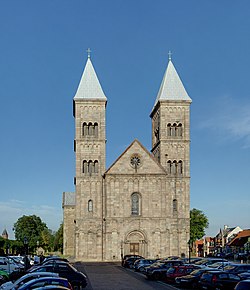Viborg Cathedral
| Viborg Cathedral | |
|---|---|
| Danish: Viborg Domkirke, Vor Frue Domkirke | |
 |
|
| Coordinates: 56°27′1.8″N 9°24′44.39″E / 56.450500°N 9.4123306°E | |
| Location | Viborg |
| Country | Denmark |
| Denomination | Evangelical Lutheran Church in Denmark |
| Previous denomination | Roman Catholic Church |
| Website | www.viborgdomsogn.dk |
| History | |
| Founded | 1876 |
| Architecture | |
| Status | Cathedral |
Viborg Cathedral, Our Lady Cathedral (Danish: Viborg Domkirke eller Vor Frue Domkirke) is the site of one of Denmark's most important historic churches located in the town of Viborg in northern Jutland. The modern building is a 19th-century construction based on Lund Cathedral in southern Sweden which bears no resemblance to the medieval cathedral that stood on the site since 1130.
Before Viking times, the town of Viborg was one of the four major centers for religion and politics in ancient Denmark. As early as 800 there was a Viking settlement at Viborg which lies in north central Jutland with connections to the Lim Fjord, an important water "highway" through Jutland until modern times.
The people of Denmark were religious people, but it is difficult to know precisely how they practiced religion, because they did not write about it themselves, and the descriptions of early Christian missionaries only hint at how and what the Danes worshiped. Scholars suggest that Danish life was centered in a region led by chiefs. Perhaps a reminder of the days when Danes were several tribes who settled in Jutland and the islands with a common language and culture. Nearly everyone was connected to the land and the sea for the necessities of life. Danes followed the gods which oversaw different aspects of life. For example fertility deities Freyr and Nordyr were important for planting and harvesting. From time to time during the year people made offerings and performed prescribed rituals to guarantee successful harvest. Odin was the god of warriors and when the men set off across the sea to ravage and plunder, the aid of Odin and Thor would have been critical. In addition to the Aesir, the world was filled with less glorious beings who had more of an impact on a regular basis. The fields, forests, moors and the sea were inhabited by various spirits, sprites, demons, and monsters that lurked in the shadows. Daily life incorporated rituals to encourage luck, health, and wealth and avert evil, envy, and accidents. Religion in Denmark was not organized in the sense of an organized religion or even a common set of beliefs or practices throughout Denmark. Theirs was a tribal and family way of living from day to day that incorporated religion on an "as needed" basis.
There were sacred spaces in all areas of Denmark, especially springs (Danish: kilder) which were often the site of local worship of the local land spirits. Beech groves of magnificent height and age would be akin to outdoor cathedrals where silence reigned when the help of the gods was invoked. High hills in a country with no real mountains would be another natural place that would draw people to worship. While people other parts of northern Europe worshiped stone or wooden images in sacred enclosures, nothing like that has been recorded in Denmark. Danish religion before 695 was not a single religion but many local variations on common themes.
...
Wikipedia

